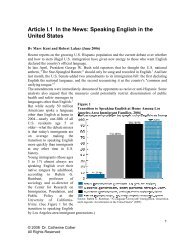A Synthesis of Research on Effective Interventions for Building ...
A Synthesis of Research on Effective Interventions for Building ...
A Synthesis of Research on Effective Interventions for Building ...
Create successful ePaper yourself
Turn your PDF publications into a flip-book with our unique Google optimized e-Paper software.
400JOURNAL OF LEARNING DISABILITIES(Table 4 c<strong>on</strong>tinued)Author/participantTreatment descripti<strong>on</strong>/sampleage/design size/treatment durati<strong>on</strong> Dependent measures Results/effect sizes (d)Smith (c<strong>on</strong>tinued)Multi-element singlesubjectdesign. Modeling: Teacher read passage <strong>for</strong>1 minute at 100 wpm. Child c<strong>on</strong>tinuedreading from where teacher stopped. Modeling with correcti<strong>on</strong>: Same asmodeling, plus correcti<strong>on</strong>s providedduring student reading. Modeling with correcti<strong>on</strong> and previewing:After modeling, student reread themodeled porti<strong>on</strong> and c<strong>on</strong>tinued to read<strong>for</strong> 5 minutes. Follow-up: Student read passage additi<strong>on</strong>altime.Length and durati<strong>on</strong>: Not specified, allc<strong>on</strong>diti<strong>on</strong>s administered <strong>on</strong>ce.each additi<strong>on</strong>al interventi<strong>on</strong>comp<strong>on</strong>ent.Maximum fluencyand accuracyachieved under themodeling with correcti<strong>on</strong>and previewingc<strong>on</strong>diti<strong>on</strong>.Weinstein & Cooke, 19928 years 1 m<strong>on</strong>th–10 years2 m<strong>on</strong>thsMulti-treatment, singlesubjectdesign (ABACA)N = 4Baseline: Each student read first set <str<strong>on</strong>g>of</str<strong>on</strong>g>3 passages <strong>for</strong> first baseline phase.The same passages were used in theinterventi<strong>on</strong> c<strong>on</strong>diti<strong>on</strong>s. Same procedurewas used <strong>for</strong> the sec<strong>on</strong>d set <str<strong>on</strong>g>of</str<strong>on</strong>g>passages. Third set <str<strong>on</strong>g>of</str<strong>on</strong>g> 3 passageswere used <strong>for</strong> final baseline.Interventi<strong>on</strong> (10 min./day):1. Students listened to taped model at100 wpm.2. Students asked to read passagequickly and accurately.3. For fixed criteri<strong>on</strong> phase, each studentreread the passage twice daily until heor she met the specified criteri<strong>on</strong> <str<strong>on</strong>g>of</str<strong>on</strong>g> 90wcpm.4. For improvement phase, studentsreread a passage until they achieved3 successive improvements.5. Results were plotted and shared withstudent immediately.Oral reading fluency All students madeprogress over baseline;mean gainsranging from 16.1 to39.4 words correctper minute. Mean gain <strong>for</strong> thefixed-rate phase =62% Mean gain <strong>for</strong> the improvementphase =58% Generalizati<strong>on</strong> improvedafter improvementphase from 5%to 89% but wasmixed <strong>for</strong> fixed-ratephase, ranging from–25% to 56%.aNegative d reflects positive outcome favoring treatment listed first.the repeated reading c<strong>on</strong>diti<strong>on</strong>s, butboth repeated reading c<strong>on</strong>diti<strong>on</strong>s resultedin significantly higher scoresthan the single reading c<strong>on</strong>diti<strong>on</strong>.Similarly, Sindelar et al. (1990) foundthat rereading text three times resultedin significantly better per<strong>for</strong>mance <strong>on</strong>a measure <str<strong>on</strong>g>of</str<strong>on</strong>g> oral reading fluency thanreading the text <strong>on</strong>ce. Similar differenceswere noted <strong>on</strong> a comprehensi<strong>on</strong>measure.Types <str<strong>on</strong>g>of</str<strong>on</strong>g> feedback. Findings from <strong>on</strong>esingle-subject sample relate to the influence<str<strong>on</strong>g>of</str<strong>on</strong>g> feedback during repeatedreading. Smith (1979) found that followingteacher modeling <str<strong>on</strong>g>of</str<strong>on</strong>g> fluentreading, providing the correct wordswhen the student read words incorrectlyduring oral reading resulted inan increase <str<strong>on</strong>g>of</str<strong>on</strong>g> more than 20 words correctper minute over baseline, and errorsdecreased from 13.6 to 9.4 errorsper minute.Criteria <strong>for</strong> repeated reading. Elevensingle-subject samples studied the influence<str<strong>on</strong>g>of</str<strong>on</strong>g> establishing particular criteria<strong>for</strong> repeated-reading interventi<strong>on</strong>s.Using an alternative treatment design,Weinstein and Cooke (1992) comparedrepeated reading using a criteri<strong>on</strong> <str<strong>on</strong>g>of</str<strong>on</strong>g>90 words per minute (fixed rate) witha criteri<strong>on</strong> based <strong>on</strong> individual improvementas a basis <strong>for</strong> increasing thedifficulty <str<strong>on</strong>g>of</str<strong>on</strong>g> the text. They found thefixed-rate criteri<strong>on</strong> more effective thanthe individual improvement criteri<strong>on</strong>,although the individual improvementseemed to facilitate generalizati<strong>on</strong> tounpracticed text.Similar to the fixed criteri<strong>on</strong> c<strong>on</strong>diti<strong>on</strong>studied by Weinstein and Cooke(1992), Lovitt and Hansen (1976) designedan interventi<strong>on</strong> that requiredstudents to meet a particular set <str<strong>on</strong>g>of</str<strong>on</strong>g> criteria(> 75 words read correctly perminute, < 4.5 errors per minute, and87% comprehensi<strong>on</strong> questi<strong>on</strong>s correct)in order to skip a difficulty level <str<strong>on</strong>g>of</str<strong>on</strong>g> text.
















